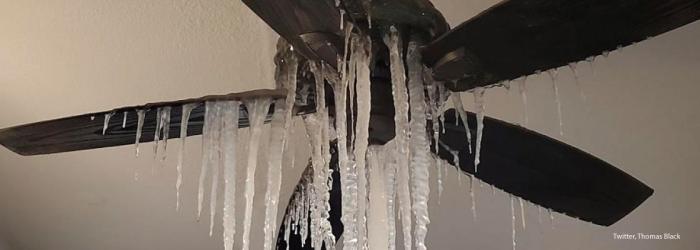2021 Winter Storms – Insurance Claim and Recovery Help

If frozen or burst pipes or ice or heavy snow from recent extreme winter weather damaged your home or business, United Policyholders’ Roadmap to Recovery program will help guide you on documenting and calculating the cost of needed repairs, understanding and enforcing your rights to the insurance coverage you paid for, getting a fair claim settlement and finding qualified professional, charitable, and government help.
Property insurance policies should cover damage caused by winter storms, including unexpected burst pipes and the resulting damage when water wicks into insulation, flooring, walls, etc.. However, the damage 2021 winter storms caused throughout Texas and other impacted states is extensive and involves water and roofs, and some insurers have already signaled that they will be rejecting some claims and limiting payouts for repairs due to language they’ve written into their policies.
Property owners are advised to focus on getting a complete current copy of their insurance policies, finding reputable professional help to make temporary repairs and drying out moisture ASAP. Things are still chaotic in the impacted regions, there is a limited supply of local trustworthy repair pros, and it’s important to protect your property from further damage while you sort out options and opinions about the best way to restore your assets.
If snow accumulates on the roof and it collapses, or ice dams formed due to melting and re-freezing caused water to seep into your ceiling and walls, your insurer should pay for needed repairs (above the applicable deductible) to restore your property as close as possible to its pre-loss condition. The statewide power outages in Texas and other states were beyond the control of property owners and your insurer should not withhold benefits to pay for repairs by pointing the finger at a utility company or agency.
Ice Dam and Insurance Claim Tips |
Key Tips
- If you detect a leak, turn off the water supply immediately.
- Take photos of the damage before any clean-up or repairs are done and completely document and value all damages and costs to repair or replace your property.
- Keep a diary of conversations with insurance, repair, government, and other professionals.
- Focus on drying/cleaning out, avoiding further damage, while getting all damage inspected, measured, and estimated by qualified, reputable, and independent experts. Mold can start growing in one day.
- Start working on a detailed and itemized “proof of loss” form but don’t rush and leave things out.
- Give your home insurer a chance to do the right thing, but advocate for yourself and be prepared to get help if you’re not being treated fairly. Sources of help include professional claim advocates and attorneys, FEMA, and your state’s Department of Insurance. You may have damage covered by both your homeowners and flood policies. Please visit our State-by-State library for additional resources.
- If your insurance company’s adjuster says damage isn’t covered, but you feel it should be, get an independent professional opinion before giving up on getting some or all of your claim paid.
If your home is damaged or destroyed, our guidance on insurance, clean up and professional claim, construction and legal services will help you get started on the road to recovery and make good decisions or repairing or rebuilding or replacing your home. United Policyholders is a nationally recognized and trusted non-profit organization with 30 years of experience in communities hit by catastrophic losses from disaster. We’re rooting for you and here to help. No strings attached.
Recovery Tools
UP offers the following tools to aid insurance consumers in their recovery.
- The Disaster Recovery Handbook/Household Inventory Guide: Since 2006 “The Disaster Recovery Handbook and Household Inventory Guide” has been a trusted book that’s led thousands of people through the process of overcoming obstacles to repairing and rebuilding after a major loss. The book is written in plain language by disaster survivors for disaster survivors with tips and expert advice from legal, insurance and personal finance professionals (where funding is available to cover costs).
- Home Inventory Worksheets: Most disaster survivors must prepare an itemized and detailed inventory list of every single item they lost in order to recover insurance monies and/or claim tax losses. Creating this inventory is one of the most challenging and time-consuming tasks survivors must complete on the road to recovery. To ease this burden, download UP’s home inventory worksheets.
- Taking it in and Getting Started
- Arranging Temporary Housing
- Getting Organized, Informed and Empowered
- Being Proactive in Documenting and Valuing Your Losses
- Creating Your Home Inventory and Navigating Your Contents Claim
- Making Housing and Financial Decisions
- Choosing a Contractor
- Working with Your Mortgage Company
- Getting help if/when you need it
- Taking Care of Yourself Along the Way
